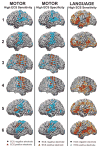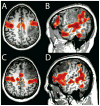Resting-state blood oxygen level-dependent functional magnetic resonance imaging for presurgical planning
- PMID: 25441506
- PMCID: PMC4291182
- DOI: 10.1016/j.nic.2014.07.009
Resting-state blood oxygen level-dependent functional magnetic resonance imaging for presurgical planning
Abstract
Resting-state functional MR imaging (rsfMR imaging) measures spontaneous fluctuations in the blood oxygen level-dependent (BOLD) signal and can be used to elucidate the brain's functional organization. It is used to simultaneously assess multiple distributed resting-state networks. Unlike task-based functional MR imaging, rsfMR imaging does not require task performance. This article presents a brief introduction of rsfMR imaging processing methods followed by a detailed discussion on the use of rsfMR imaging in presurgical planning. Example cases are provided to highlight the strengths and limitations of the technique.
Keywords: Eloquent cortex; Functional MR imaging; MLP; Multilayered perceptron; RSNs; Resting-state functional MR imaging; Resting-state networks; rsfMR imaging.
Copyright © 2014 Elsevier Inc. All rights reserved.
Figures







References
-
- Posner MI, Raichle ME. Images of mind. New York: Scientific American Library: Distributed by W.H. Freeman and Co; 1997.
-
- Spitzer M, Kwong KK, Kennedy W, Rosen BR, Belliveau JW. Category-specific brain activation in fMRI during picture naming. Neuroreport. 1995 Nov;6(16):2109–2112. - PubMed
-
- Clarke DD, Sokoloff L. [Accessed: 08-Apr-2014];Circulation and Energy Metabolism of the Brain. 1999 [Online]. Available: http://www.ncbi.nlm.nih.gov/books/NBK20413/
-
- Raichle ME, Mintun MA. Brain Work and Brain Imaging. Annu Rev Neurosci. 2006;29(1):449–476. - PubMed
-
- Shulman RG, Rothman DL, Behar KL, Hyder F. Energetic basis of brain activity: implications for neuroimaging. Trends Neurosci. 2004 Aug;27(8):489–495. - PubMed
Publication types
MeSH terms
Substances
Grants and funding
LinkOut - more resources
Full Text Sources
Other Literature Sources
Medical

